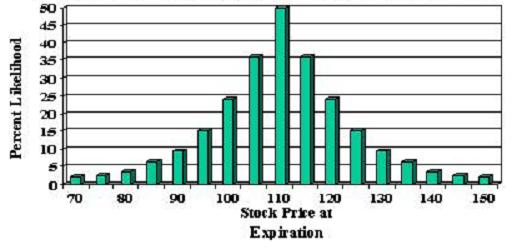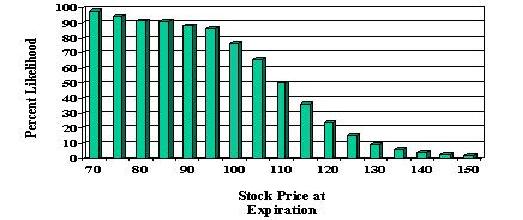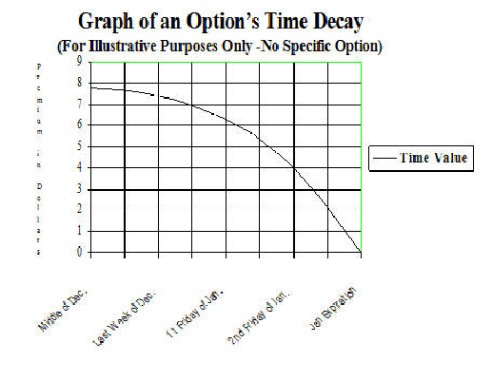Objective: This article is dedicated to those who are determined to improve their chances of success by grounding their education in a study of the option greeks. The wonderful thing about Greeks is that even though the math can be a bit intimidating to those who have not had an advanced algebra class, the amount of math needed to master the practical aspects is minuscule. In short, there should be no reason for people to not understand enough to improve their trading and to know why they are making or losing money.
Practical Introduction: The powerful benefit of option trading is that you can choose your risk parameters. Options have five variables which move the option price, whereas stock only has one – delta. The toughest thing in the world is picking stock direction, and even the best gun slingers have difficulty beating a 50/50 success rate. Options, however can be profitable not only because of stock direction (delta), but also because of the intensity and severity in which the underlying stock moves (gamma). They can make money if the market becomes more or less volatile (vega) or as time to expiration approaches (theta). A well predicted interest rate estimate can also favorably affect the option prices (rho). In short, you choose your poison.
Definitions
Delta: The measure of the change of an option’s value with respect to a 1 point move in its underlying (stock, future, commodity, etc.). Calls have a positive delta while puts have a negative delta.
Gamma: The measure of the change of an option’s delta with respect to a 1 point move in its underlying (stock, future, commodity, etc.). After the first 1 point move in an underlying, the probability of the option being ITM at expiration has changed, and therefore so has its delta. Gamma measures that change in delta.
Vega: The measure of the change of an option’s price with respect to a 1-point move in its implied volatility.
Theta: The amount of change of an option’s price with respect to a 1-day change in time.
Rho: The amount of change of an option’s price with respect to a 1-point change in interest rates.
Delta: Delta is the measure of the change of an option’s value with respect to a 1 point move in its underlying (stock, future, commodity, etc.). Calls have a positive delta while puts have a negative delta.
Long Calls (Positive Deltas): Long calls (purchased options) have a positive delta because the owner is expecting to profit from owning the option should the price of the underlying increase. The owner of the XYZ 80-strike call bought the option for $1.00 when the stock was at $78 per share. After the stock increased to $88 per share the owner of the option knows that the positive increase in the stock’s value allowed his investment to increase at the minimum (no consideration for time value) to $8 per option.
Short Calls (Negative Deltas): The seller of the 80-strike call (in the above example) lost money due to the advance in the price of the underlying, thus we can say that a short call has negative deltas. Another way of stating this is that the seller of the calls profits when the value of the underlying is at or below the strike price at expiration, thus the sale of a call produces negative deltas. All calls have positive deltas; however, when selling a call, place a negative sign in front of the delta to designate it was a sale.
Long Puts (Negative Deltas): Long puts (purchased options) have a negative delta because the owner is expecting to profit from owning the option should the price of the underlying decrease. The owner of the XYZ 75-strike put bought the option for $1.50 when the stock was at $78 per share. After the stock decreased to $68 per share, the owner of the option knows that the negative movement in the stock’s value allowed his investment to increase, at the minimum (no consideration for time value), to $7 per option.
Short Puts (Positive Deltas): The seller of the 75-strike put lost money due to the decrease in the price of the underlying. We can say that a short put has positive deltas, as the seller is hoping for an increase in the price of the stock. Another way of stating this is the seller of the put profits when the value of the underlying is at or above the strike price at expiration, thus the sale of a put produces positive deltas. All puts have negative deltas; however, when selling a put, place a negative sign in front of the delta to designate it was a sale. A negative multiplied by a negative is a positive number.
Probability Curve of Stock That Is Currently Trading For $110 Per Share
Stock has 4 weeks to expiration and is trading on a 48 Volatility (i.e. IBM)
The below curve shows that the stock currently has a 50/50 chance of being above or below its current price ($110) on expiration. Furthermore, looking at the graph one can calculate that there is approximately a 2% chance that the stock will close as high as $150 per share or as low as $70 per share.

Probability Curve of Option Being ITM At Any Given Strike
Stock has 4 weeks to expiration and is trading on a 48 Volatility (i.e. IBM)
The below curve shows that the 110 Strike Option currently has a 50/50 chance of being above or below its current price ($110) on expiration. Furthermore, looking at the graph one can calculate that there is approximately a 2% chance that the 150 Strike Call will close ITM, and roughly 98% chance that the 70 Strike Call will be ITM.

Call Example with Stock Increasing
Stock CHTR is trading for $95 per share. If we bought the 95-strike call in the anticipation that the stock was going to make a $1 move (to $96 per share), what would the option that we paid $4 for be trading at after the move? Delta answers the question. Given that the delta of the $95-strike call is .50 (all ATM options are 50 deltas – long calls are positive deltas and long puts are negative deltas), the option will move $0.50 cents for the first dollar the stock moves. The 95- strike call starts out trading at $4 and would end (with the stock at $96) trading at $4.50.
Example:
or [$0.50] + $4 = $4.50
Gamma
Gamma is the measure of the change of an option’s delta with respect to a 1 point move in its underlying (stock, future, commodity, etc.).
Previously we learned that an option’s delta was a function of the option’s probability of being in or out-of-the-money at expiration. This probability changes as the stock moves closer to, or further away from, its current position. As a stock moves closer to or further from the strike of an option, its probability changes. This rate of change in probability is called gamma.
Example:
Assume the RSR 95-strike call has a .50 delta when the stock is at $95. Should the stock immediately run up to $101 per share, the likelihood that the option will be ITM at expiration has greatly increased compared to when the stock was at only $95 per share. The option is now $6 ITM. Obviously, it has a greater than 50/50 chance of being ITM as the stock could sell off $5 (to $96) and still be ITM. Let’s say that with the stock at $101, the 95-strike call has a 70% chance (a .70 delta) of being ITM at expiration. The option’s delta has changed from a .50 delta to a .70 delta because the likelihood of it being worth anything at expiration has changed. The cause of the change was the price movement of the stock. The measure of the change in delta is gamma.
Vega
Vega is the measure of how much a particular option will change in value because of a 1 point change in implied volatility. Vega is the most powerful greek affecting an option’s price.
Vega Quantified: Vega is a mathematical calculation and tool to determine how much an option will change in price as volatility changes one point. If the vega of an option is 0.38, that means the price of the option will move $0.38 cents for every 1 percentage point move in volatility. If the volatility increases, the price of the option will increase, and vice versa.
Example:
OEX is trading at $532
Assume the 535 strike as the ATM strike
The VIX is trading at 20%
The OEX 535 call is trading for $5.20 with 10 days until expiration
The Delta of the 535 call is .45 long deltas
The Vega of the 535 call is .38 cents.
Question: The volatility of the OEX ATM call is currently trading at 20%, and even though the market hasn’t moved at all, the volatility just bounced up to 22%. Knowing what just happened (a 2 volatility point increase in the VIX index), what will the 535 call be trading for if the starting price at 20% volatility is $5.20? Assume no change in any other variable such as time to expiration.
Answer:[0.38 (vega) x 2 (volatility point increase)]
+ $5.20 (option starting price) =[$0.76] + $5.20 =
$5.96 End Price at 22% Volatility
Theta
Theta is a measure of how much an option loses value daily as time approaches expiration. Theta increases in size as it nears expiration. What this means is that the closer to expiration an option is, the quicker it loses its time value.
The chart below shows how the value of an option decreases as time approaches expiration. This chart is taking into consideration that no other variables are at work, meaning the stock is not moving. The only thing affecting the time value (TV) of the option is the passage of time.

Rho
Rho is how much an option changes in value with respect to a 1% point change in interest rates. It is usually the weakest of all option variables.
The reason that interest is used in the pricing of an option is because when you buy an option, you are spending money that could be otherwise sitting in an account collecting interest. So, the fact that the option is in your account instead of cash has a theoretical cost associated with it.
Think of it this way. You and your neighbor both have $100,000 in cash. Because you do not trust banks, you bury your money in your back yard. Your neighbor puts his money in bonds that collect 8% interest. At the end of the year, provided your money wasn’t stolen, he will have about $8,000 more than you. The cost associated with your unique savings and loan was $8,000.
Options work the same way. Because you could be collecting money in interest, the option has to return at least what you would make in a savings account for it to be a viable investment. As such, the popular option pricing models such as Black & Scholes use interest in determining the value of an option.
Caring about your success.
